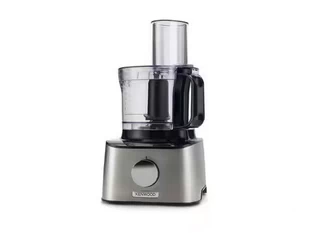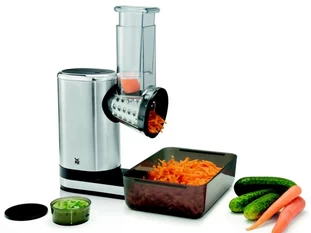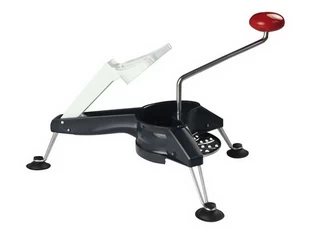This site uses only a few technical cookies necessary for its operation. By continuing to browse, you accept their use.
To find out more...
To find out more...
It's spinning too fast!

When you need to grate or slice vegetables, you generally use an electric machine that does all the work: a food processor, a mixer with a "slicer" extension or similar.
Are these machines really suitable? Generally speaking, yes of course, but there's one criterion that often poses a problem, and that's speed.
Are these machines really suitable? Generally speaking, yes of course, but there's one criterion that often poses a problem, and that's speed.
11 K 5/5 (2 reviews)
Keywords for this post:EquipmentGratingBeatingKneadingSpeedRotationLast modified on: November 12th 2023
It's spinning too fast!
It happens very, very often in the kitchen, when you need to grate, julienne or slice vegetables for one of your recipes.
You wash them, peel them, and then run them through one of your machines using the right disc or grater.
We all do this, and it's only natural, after all: it's super-fast, super-convenient and relatively efficient.
Many of us use what in France is called a "robot-coupe", or equivalent, a food processor with a simple electric motor and cutting discs of various sizes.
Granted, it works very fast - it takes 2 or 3 seconds to grate a carrot, for example - but it has an annoying tendency to sometimes rough up the vegetables, and to make carrot purée and juice at the same time as it grates - you'll find a bit of this at the bottom of the machine's bowl. This is even more pronounced with tender vegetables such as zucchinis or cucumbers.
This isn't too bad for a simple carrot salad, you may say, but you have to admit that what is grated with this tool is necessarily in very, very small, very fine pieces, and sometimes this isn't great for the recipe and its texture.
The problem is that the food processor runs too fast, much too fast for this job, and therefore produces this "purée" effect, which is a bit painful.
It's almost impossible to reduce the speed of the machine (I've tried using a variable speed drive on mine), it starts to work badly, so what can you do?
Well, you "still" have to buy a new electric machine, which takes up a lot of space, but it's a good option.
To sum up: conventional food processors run too fast when cutting or grating vegetables, and are far less efficient than a dedicated vegetable grater that "spins" much more slowly, or even better, a simple and economical hand grater.
You wash them, peel them, and then run them through one of your machines using the right disc or grater.
We all do this, and it's only natural, after all: it's super-fast, super-convenient and relatively efficient.
Many of us use what in France is called a "robot-coupe", or equivalent, a food processor with a simple electric motor and cutting discs of various sizes.

Granted, it works very fast - it takes 2 or 3 seconds to grate a carrot, for example - but it has an annoying tendency to sometimes rough up the vegetables, and to make carrot purée and juice at the same time as it grates - you'll find a bit of this at the bottom of the machine's bowl. This is even more pronounced with tender vegetables such as zucchinis or cucumbers.
This isn't too bad for a simple carrot salad, you may say, but you have to admit that what is grated with this tool is necessarily in very, very small, very fine pieces, and sometimes this isn't great for the recipe and its texture.

The problem is that the food processor runs too fast, much too fast for this job, and therefore produces this "purée" effect, which is a bit painful.
It's almost impossible to reduce the speed of the machine (I've tried using a variable speed drive on mine), it starts to work badly, so what can you do?
The alternatives

Well, you "still" have to buy a new electric machine, which takes up a lot of space, but it's a good option.

To sum up: conventional food processors run too fast when cutting or grating vegetables, and are far less efficient than a dedicated vegetable grater that "spins" much more slowly, or even better, a simple and economical hand grater.
Lasts posts
Butter vs. grease
We often read in a recipe where a pastry is put into a mould that, just before pouring, the mould should be buttered or greased. But what's the difference between these 2 terms?December 1st 20259665
Getting out of the fridge early
Very often when you're cooking, you need to take food or preparations out of the fridge, to use them in the recipe in progress. There's nothing tricky about this: you just take them out of the fridge and use them, usually immediately, in the recipe. But is this really a good method?November 24th 20251,0985
Who's making the croissants?
When you look at a bakery from the outside, you naturally think that in the bakery, the bakers make the bread, and in the laboratory, the pastry chefs make the cakes. It's very often like that, with each of these professions having quite different ways of working, but sometimes there's also one...November 23th 2025993
Oven height
When we put a dish or cake in the oven, we naturally tend to put it on the middle shelf, and that's what we usually do. But in some cases, this position and height can be a little tricky, so let's find out why.October 8th 20252,7165
The importance of sieving
In recipes that use a fine powder (flour, powdered sugar, etc.), you'll often see the advice to sift before using it. To sift is to pass the powder in question through a sieve (a very fine strainer) before incorporating it into your recipe. It's often advice, but is it really useful?September 3rd 20257,5253
Other pages you may also like
The return of the "Norman hole"
You maybe know the "trou normand", this old gastronomic custom typically French which consists in taking a (small) glass of calvados, generally between the last course and the dessert? It's something that seems a bit anachronistic nowadays, having a glass of an alcohol of more than 60° in the...December 18th 202115 K4.8
Choosing a chopping board
It's a no-brainer, surely? If you want a chopping board, just find a piece of wood, and Bob's your uncle! You can happily chop away with a knife and not damage the table or worktop. But in reality, it's a bit more complicated than that. You need to be careful what you are buying, in particular the...May 8th 201250 K4.6
Beans in primeur
As I write this, it is the beginning of the short season for fresh beans. If you've never made them before and you're just starting out (and that's a great idea) you'll find that it's a bit time consuming to prepare, you have to shell them once, remove the beans, scald them to remove the skin (and...June 4th 202214 K
Parmesan cheese crusts
If you use Parmesan cheese (Parmigiano Reggiano) in your recipes, you may have already noticed: when you grate it, it becomes (very) difficult near the crust, especially if it is a slightly aged parmesan, as the cheese gets harder and harder. So we stop grating, leaving some crust on top, and a...September 14th 202217 K4.9
How to properly roll out a pie crust?
Very often in pastry making, you have to roll out a pastry before using it for a pie or another dessert. At home, of course, you get out your rolling pin and simply roll it out. Is there a way to get an evenly rolled out dough? That's what we will see in this article.May 10th 202310 K4.9
Post a comment or question
Follow this page
If you are interested in this page, you can "follow" it, by entering your email address here. You will then receive a notification immediately each time the page is modified or a new comment is added. Please note that you will need to confirm this following.
Note: We'll never share your e-mail address with anyone else.
Alternatively: you can subscribe to the mailing list of cooling-ez.com , you will receive a e-mail for each new recipe published on the site.









